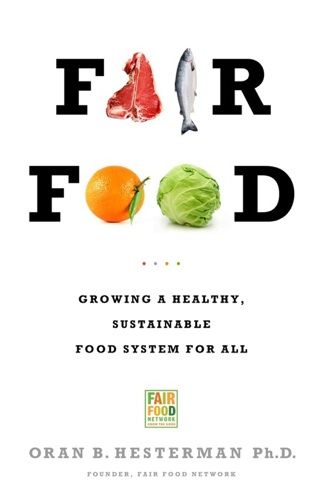This summer, First Lady Michelle Obama stood alongside executives from some of the largest food retailers in the country to announce their commitment to expanding stores in areas known as “food deserts,” or communities that lack adequate access to grocery stores, in order to improve access to healthy foods. Ever since planting a vegetable garden on the White House’s South Lawn, Mrs. Obama has emerged as an important voice in the growing food movement.
Oran B. Hesterman, author of the justice-seeking new book Fair Food: Growing a Healthy, Sustainable Food System for All, would caution us to pause, however, before celebrating this latest victory. He writes that if we solely depend on grocery stores to address challenges to accessing healthy food, “we merely will have created more opportunities for residents to purchase (usually at higher prices than in the suburbs) primarily highly processed foods in a way that also very rapidly siphons money away from their community.” His cautionary tale was recently corroborated by a new study, which reveals that access to grocery stores does not improve health due to the high selection of unhealthy food.
While Hesterman would commend Mrs. Obama’s work (given his focus on Detroit, which does not have a single supermarket), his book aims to pull people away from addressing the symptom’s of our broken food system, and understand the need to redesign the system all together. Despite this thesis, he starts by talking about how logical the current system is: “a food system that allows less than 2 percent of our population to feed the rest of us…is exactly the system you want to free the other 98 percent to develop other sectors of the economy.” The specialized and centralized system we participate in once liberated individuals from the farm to explore other aspects of society, spurring innovation and advances in other fields. The system just needs to adjust once again.
Hesterman rapidly goes through the consequences of our current food practices and policies – poor food quality, poor food safety, animal welfare, soil erosion, pollution, climate change, inadequate food access, loss of farmland – almost assuming the reader has prior knowledge of these issues and is past the need of an exposé. Unlike preceding works that document the horrors of the modern food system (think Eric Schlosser, Michael Pollan), Hesterman’s book is mostly concerned with how to change the system. And he doesn’t just mean buying organic or supporting farm-to-table restaurants (although he believes this is important). He explains, “we just need to realize that the organic label alone can’t provide all the information we need if our intention is to support a fair food system.” For him, addressing the food system goes deeper, and is also about improving the conditions of field workers and the circumstances of inner city residents.
His focus on equity is refreshing in a genre of nonfiction books that caters to the diets and desires of middle- and upper-class readers. He often uses provocative language to describe the injustices of the food system, though more for accuracy than shock value. He speaks of what he terms “nutritional redlining” where families are “systematically denied access” to fresh food because of race and class issues, and discusses “modern-day slavery” in the tomato fields in Florida (chronicled in the new book Tomatoland by Barry Estabrook). He also describes issues of structural racism, such as the federal government’s admission that black-owned land has been “more vulnerable to land grabs by developers and the government,” resulting in a 97 percent decline in the number of black-owned farms since 1920.
It would be a mistake, however, to interpret this as Hesterman positioning low-income communities and migrant workers against “elites” as he designates the more privileged members of society. A self-aware elite, Hesterman advocates for policies that benefit everyone, and demands that particular attention be paid to populations who are often left out of the equation. He suggests a “trickle-out” approach to the food system, explaining “if we ensure that those on the bottom rungs of the economic ladder have access to good food, perhaps we will have a better chance of creating a healthy system for everyone.”
In addition to equity, Hesterman believes a redesigned food system must also encompass the principles of diversity, ecological integrity, and economic viability. A diverse rotation of crops helps preserve soil quality, and recognition of a diverse population expands business practices. Preservation of our resource base, such as water and land, from pollution and erosion will protect our long-term food production prospects as well as our health. And an economically viable system ensures that everyone in the supply chain benefits and is fairly treated.
Hesterman does not just preach these principles, but has applied them to his long career throughout the food system. He has worked as a farmer, food salesman, professor in the Department of Crop and Soil Sciences at Michigan State University, and was program director for Food Systems at the W.K. Kellogg Foundation for over 15 years. His time with the Kellogg Foundation exposed him to a myriad of innovative programs documented in the book, such as college students shifting their university’s food purchases to local and sustainable food, and “Double Up Food Bucks,” a Michigan program to encourage low-income populations to shop at farmer’s markets by doubling the value of food stamps. In addition, he chronicles corporations, such as Sysco and Costco who are working to shift their business models to utilize a sustainable and just supply chain.
The last section of his book provides advice on what ordinary citizens can do to change their communities and shift the food system. It discusses voting with our dollars by changing the way we eat, gives advice on how to affect the food procurement of institutions such as university’s and hospitals, and discusses strategies for shifting public policy. He also includes a directory of every organization that inspires action or could offer advice.
Fair Food covers a lot of territory, which also means it doesn’t dive too deeply into any one subject. He touches on everything just enough to enhance the reader’s understanding, but not enough to be hard hitting on many of the topics he cares most about. And that seems to be the point. This book is not intended to serve as an encyclopedia for the food movement, but more of a practical guide for concerned citizens and budding activists. It fails to conjure up some of the emotions similarly positioned books do, but doesn’t leave you wondering “what can I do to change things?” Hesterman’s goal for Fair Food is not to shock the masses, but to mobilize them to action.

Tracey Ross, Associate Director of the All-In Cities Initiative at PolicyLink, works with cities across the country to adopt policies and practices to promote racial inclusion and equitable growth. Prior to joining PolicyLink, Tracey worked at the Center for American Progress focused on urban poverty and environmental justice, and at Living Cities on place-based efforts. In 2012, she was selected as a “Next Vanguard,” Next City’s recognition of 40 urban leaders under 40. Her writing has appeared in The New York Times, ESSENCE, The Washington Post, The Root, The Nation, EBONY.com, and ThinkProgress.












